
Location: Henderson Courthouse in Henderson, Kentucky, October, 2005. The plaques are located at 20 N. Main Street. Photos taken May, 2007.

Two Transylvania Plaques are mounted on each side of the doors. Two more are located inside the building with a tablet that explains the plaques. Honig's name appears on all plaques except the one that contains text.
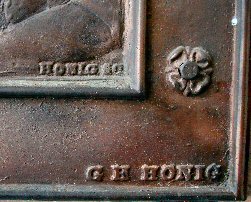


This plaque is located on the front, left side of the building.
The text at the top reads: March 31, 1797, General Samuel Hopkins as agent and attorney in fact for the Transylvania Co. with Colonel Thomas Allin, their surveyor, laid off the Town of Henderson, named for Richard Henderson.
The text at the bottom reads: President of the Transylvania Co., called Richard Henderson and Co., twelve years after his death
Boonesborough, Nashville, Henderson, Daughters of the Transylvania Company.


This plaque is located on the front, right side of the building.
The text at the top reads: The Treaty of Watauga at Sycamore Shoals March 14-17, 1775. Largest real estate transaction between private individuals and Indian tribes in American history. The Transylvania Co. purchased from the Cherokee Tribe 20,000,000 acres in N.C., Va., Tenn., & Ky. To establish an independent government and open
The text at the bottom reads: Kentucky to settlement. Present at Chas Robertson's Fort-Proprietors: Henderson, Thomas and Nathaniel Hart, Williams, Duttrell, 5 Chiefs, 1,200 Indians, 200 Pioneers-March 10, 1775. Henderson sent Boone with 30 axemen to cut Transylvania Trail from Long Island of Holston R. to future site of Boonesborough.
The names of Indians and pioneers appear at the top of the plaque. Dragging Canoe, Savanooka, Atta Kulla Kulla, Oconostota, Richard Henderson, Thomsa Price, Interpreter.
At the bottom, Chas Robertson, Thomas Hart, John Williams, Nathaniel Hart, Isaac Shelby, John Sevier, John Luttrell.

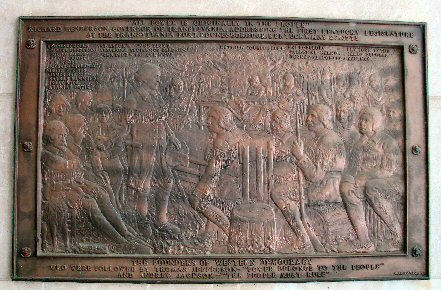
This plaque is located on the front, right side of the building. It is mounted on the inside wall.
The text at the top reads: "All Power is Originally in the People"
Richard Henderson, Governor of Transylvania Addressing the First Kentucky Legislature
At the Transylvania Fort, Boonesborough Kentucky, May 23, 1775
The text at the bottom reads: The Founders of Western Democracy
Who Were Followed by Thomas Jefferson - "Power Belongs to the People"
And Andrew Jackson - "The People Must Rule"
The names of pioneers appear at the top of the plaque.
Boonesborough: Samuel Henderson, Squire Boone, Daniel Boone, Wm. Moore, Richard Callaway.
Boiling Springs: James Harrod, Nathan Hammond, Isaac Hite, Azariah Davis.
St. Asaph's: John Floyd, Alexander Spostwood Dandridge, John Todd, Samuel Wood, Matthew Loutt, Clerk.
Harrodsburg: Rev. John Lythe, Valentine Harmon, James Douglas, Thomas Slaughter, Chairman.


This plaque is located on the front, left side of the building. It is mounted on the inside wall.
The text at the top reads: Richard Henderson and Company, Called the Transylvania Company in 1775
Send Forth Daniel Boone to Explore Tennessee and Kentucky
The text at the bottom reads: 1764 Boone Explores Tennessee
1769 - 1771 Boone Explores Kentucky
1775 Boone and Thirty Axemen Cut Transylvania Trail
The names of pioneers appear at the top of the plaque. Thomas Hart, Leonard Henley Bullock, John Luttrell, David Hart, James Hogg, William Johnston, John Williams, Nathaniel Hart, Richard Henderson, Daniel Boone, Hillsboro, North Carolina.

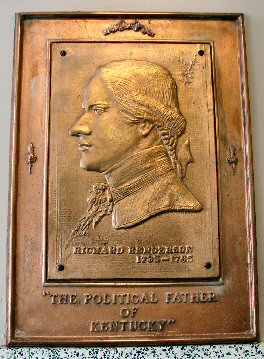
This plaque is located on the left wall between the doors.
Although Honig's name is not on this plaque, a picture of it with the Transylvania plaques is in his brochure. This brochure can be found in the Sigma Chi collection. It is similar to one in the Henderson Library. There is a rough area where his name would have appeared.
The plaque reads: Richard Henderson 1735 - 1785
"The Political Father of Kentucky"

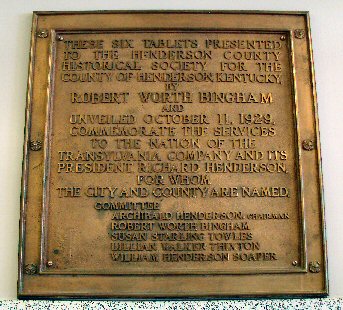
This plaque is located on the right wall inside the building. It is between the two other Transylvania plaques.
The text reads: These six tablets presented to the Henderson County Historical Society for the County of Henderson, Kentucky,
by
Robert Worth Bingham
and
Unveiled October 11, 1929.
Commemorate the services to the nation of the Transylvania Company and its President, Richard Henderson, for whom the city and county are named.
Committee
Archibald Henderson, Chairman
Robert Worth Bingham
Susan Starling Towles
Lillian Walker Thixton
William Henderson Soaper


This plaque is located on the right wall inside the building.
The text at the top reads: Rev. John Lythe conducting the first Christian service in Kentucky - Sunday, May 28, 1775 - The Transylvania Fort, under the "Divine Elm" Tree - Religious Freedom --
The text at the bottom reads: Two hundred pioneers of the Colony of Transylvania knelt and offered up Thanksgiving to the Creator for his blessings.

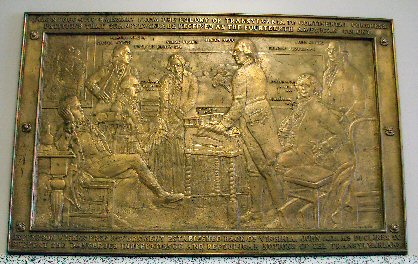
This plaque is located on the right wall inside the building.
The text at the top reads: James Hogg - 1775 - Emissary from the Colony of Transylvania to Continental Congress. Petitions that Transylvania be received as the fourteenth American Colony.
The text at the bottom reads: Jefferson wishes free government established back of Virginia. John Adams declines to support the dangerous independence and republican notions of the Transylvanians.
The names of pioneers appear at the top of the plaque. Samuel Adams, George Wythe, Silas Deane, Richard Henry Lee, James Hogg, John Adams, Thomas Jefferson. Places marked on the plaque are Henderson, March ?1, 1797, Nashville 17?0, Boonesborough, April 1, 1775, Cumberland Gap,

On the corner of the courthouse, is a granite mounment erected by the Daughter's of the American Revolution. More research needs to be done to prove these are Honig plaques but he did several for the DAR in Indiana.

1916 DAR Plaque on the front of the granite stone.
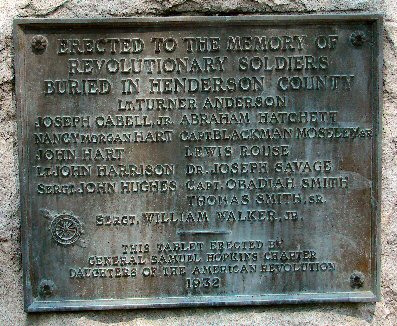
1932 DAR Plaque on the back of the granite stone.
